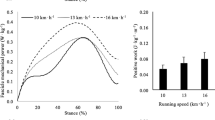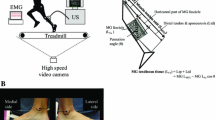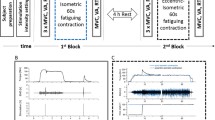Abstract
Purpose
Decreased whole-body energy cost of running has been associated with an increased Achilles tendon stiffness. It is usually assumed that this lower energy cost can be attributed to less muscle fascicle shortening with a stiffer tendon. Increased fiber shortening is an important determinant of muscle energetics in vitro. However, other factors, like increased muscle activation may be important when considering whole muscle energetics in vivo.
Methods
To determine the effects of a small additional muscle shortening on skeletal muscle energy requirement, 19 subjects performed 30 plantarflexions on two separate occasions: isometric (ISO) and isokinetic (KIN, 6.98 rad s–1), each with a target of 50 % of maximum isometric torque. Medial gastrocnemius muscle fascicle length (FL) was measured by ultrasound and rate of oxyhemoglobin (HbO2) desaturation was measured during blood flow occlusion using near-infrared spectroscopy.
Results
KIN resulted in significantly greater muscle shortening (23.8 ± 1.3 mm) than ISO (18.3 ± 1.0 mm, p < 0.001, mean ± SEM), and greater shortening velocity (KIN = 2.5 ± 0.3 FL s–1, ISO = 1.1 ± 0.1 FL s–1, p < 0.001). Rate of HbO2 desaturation was 19 ± 7 %, greater in KIN than ISO (p < 0.01), despite 19 ± 2 % lower mean torque (p < 0.001) and 9.8 ± 1.6 Nm s lower mean impulse per contraction (p < 0.001) in KIN compared to ISO. Root mean square for EMG was significantly greater (p < 0.05) during KIN (73 ± 3 %) than during ISO (63 ± 2 %).
Conclusion
These results illustrate that muscle energy requirement is greater when muscle fascicle shortening and/or velocity of shortening is increased, and suggest that greater activation contributes to that increased energy requirement.







Similar content being viewed by others
Abbreviations
- AT:
-
Achilles tendon
- d L :
-
Fascicle-aponeurosis displacement
- d ϴ :
-
Ankle joint displacement
- EC:
-
Energy cost
- EMG:
-
Electromyography
- F:
-
Force
- FL:
-
Fascicle length
- HHbO2 :
-
Deoxyhemoglobin
- HbO2 :
-
Oxyhemoglobin
- ISO:
-
Isometric
- KIN:
-
Isokinetic
- LG:
-
Lateral gastrocnemius
- M C :
-
Corrected moment
- M M :
-
Measured moment
- MA:
-
Moment arm
- MG:
-
Medial gastrocnemius
- MVC:
-
Maximal voluntary contraction
- NIRS:
-
Near-infrared spectroscopy
- RMS:
-
Root mean square
- SOL:
-
Soleus
References
Albracht K, Arampatzis A (2006) Influence of the mechanical properties of the muscle-tendon unit on force generation in runners with different running economy. Biol Cybern 95:87–96
Alexander RM (1991) Energy-saving mechanisms in walking and running. J Exp Biol 160:55–69
An KN, Takahashi K, Harrigan TP, Chao EY (1984) Determination of muscle orientations and moment arms. J Biomech Eng 106:280–282
Arampatzis A, De Monte G, Karamanidis K, Morey-Klapsing G, Stafilidis S, Bruggemann GP (2006) Influence of the muscle-tendon unit’s mechanical and morphological properties on running economy. J Exp Biol 209:3345–3357
Askew GN, Marsh RL (1998) Optimal shortening velocity (V/Vmax) of skeletal muscle during cyclical contractions: length-force effects and velocity-dependent activation and deactivation. J Exp Biol 201:1527–1540
Austin N, Nilwik R, Herzog W (2010) In vivo operational fascicle lengths of vastus lateralis during sub-maximal and maximal cycling. J Biomech 43:2394–2399
Bergstrom M, Hultman E (1988) Energy cost and fatigue during intermittent electrical stimulation of human skeletal muscle. J Appl Physiol 65:1500–1505
Biewener AA (1998) Muscle function in vivo: a comparison of muscles used for elastic energy savings versus muscles used to generate mechanical power1. Integr Comp Biol 38:703
Chow JW, Darling WG (1999) The maximum shortening velocity of muscle should be scaled with activation. J Appl Physiol 86:1025–1031
Coast JR, Welch HG (1985) Linear increase in optimal pedal rate with increased power output in cycle ergometry. Eur J Appl Physiol Occup Physiol 53:339–342
de Haan A, Jong J, Doorn J, Huijing P, Woittiez R, Westra H (1986) Muscle economy of isometric contractions as a function of stimulation time and relative muscle length. Pflügers Archiv Eur J Physiol 407:445–450
Ding H, Wang G, Lei W et al (2001) Non-invasive quantitative assessment of oxidative metabolism in quadriceps muscles by near infrared spectroscopy. Br J Sports Med 35:441–444
Farris DJ, Trewartha G, McGuigan MP (2011) The effects of a 30-min run on the mechanics of the human Achilles tendon. Eur J Appl Physiol 112(2):653–660
Fenn WO (1923) A quantitative comparison between the energy liberated and the work performed by the isolated sartorius muscle of the frog. J Physiol 58:175–203
Fenn WO (1924) The relation between the work performed and the energy liberated in muscular contraction. J Physiol 58:373–395
Ferrari M, Mottola L, Quaresima V (2004) Principles, techniques, and limitations of near infrared spectroscopy. Can J Appl Physiol 29:463–487
Finni T, Ikegaw S, Lepola V, Komi P (2001) In vivo behavior of vastus lateralis muscle during dynamic performances. Eur J Sport Sci 1:1–13
Fletcher JR, Esau SP, Macintosh BR (2010) Changes in tendon stiffness and running economy in highly trained distance runners. Eur J Appl Physiol 110:1037–1046
Foley JM, Meyer RA (2005) Energy cost of twitch and tetanic contractions of rat muscle estimated in situ by gated 31P NMR. NMR Biomed 6:32–38
Gabaldon AM, Nelson FE, Roberts TJ (2008) Relative shortening velocity in locomotor muscles: turkey ankle extensors operate at low V/V(max). Am J Physiol Regul Integr Comp Physiol 294:R200–R210
Gordon AM, Huxley AF, Julian FJ (1966) The variation in isometric tension with sarcomere length in vertebrate muscle fibres. J Physiol 184:170–192
Hamaoka T, McCully KK, Quaresima V, Yamamoto K, Chance B (2007) Near-infrared spectroscopy/imaging for monitoring muscle oxygenation and oxidative metabolism in healthy and diseased humans. J Biomed Opt 12:062105
He ZH, Bottinelli R, Pellegrino MA, Ferenczi MA, Reggiani C (2000) ATP consumption and efficiency of human single muscle fibers with different myosin isoform composition. Biophys J 79:945–961
Heglund NC, Fedak MA, Taylor CR, Cavagna GA (1982) Energetics and mechanics of terrestrial locomotion. IV. Total mechanical energy changes as a function of speed and body size in birds and mammals. J Exp Biol 97:57–66
Herzog W, ter Keurs HEDJ (1988) Force–length relation of in vivo human rectus femoris muscles. Pflügers Archiv Eur J Physiol 411:642–647
Hill AV (1938) The heat of shortening and the dynamic constants of muscle. Proc Royal Soc Lond Series B Biol Sci 126:136–195
Hogan MC, Ingham E, Kurdak SS (1998) Contraction duration affects metabolic energy cost and fatigue in skeletal muscle. Am J Physiol Endocrinol Metab 274:E397–E402
Homsher E, Mommaerts W, Ricchiuti N, Wallner A (1972) Activation heat, activation metabolism and tension-related heat in frog semitendinosus muscles. J Physiol (Lond) 220:601–625
Im J, Nioka S, Chance B, Rundell KW (2001) Muscle oxygen desaturation is related to whole body VO2 during cross-country ski skating. Int J Sports Med 22:356–360
Ishikawa M, Pakaslahti J, Komi P (2007a) Medial gastrocnemius muscle behavior during human running and walking. Gait Posture 25:380–384
Ishikawa M, Pakaslahti J, Komi PV (2007b) Medial gastrocnemius muscle behavior during human running and walking. Gait Posture 25:380–384
Ito M, Akima H, Fukunaga T (2000) In vivo moment arm determination using B-mode ultrasonography. J Biomech 33:215–218
Kram R, Taylor CR (1990) Energetics of running: a new perspective. Nature 346:265–267
Kyröläinen H, Finni T, Avela J, Komi P (2003) Neuromuscular behaviour of the triceps surae muscle-tendon complex during running and jumping. Int J Sports Med 24:153–155
Lichtwark GA, Bougoulias K, Wilson AM (2007) Muscle fascicle and series elastic element length changes along the length of the human gastrocnemius during walking and running. J Biomech 40:157–164
MacIntosh BR, Neptune RR, Horton JF (2000) Cadence, power, and muscle activation in cycle ergometry. Med Sci Sports Exerc 32:1281
Maganaris CN (2000) In vivo measurement-based estimations of the moment arm in the human tibialis anterior muscle-tendon unit. J Biomech 33:375–379
Maganaris CN (2003) Force–length characteristics of the in vivo human gastrocnemius muscle. Clin Anat 16:215–223
McCully KK, Hamaoka T (2000) Near-infrared spectroscopy: what can it tell us about oxygen saturation in skeletal muscle? Exerc Sport Sci Rev 28:123–127
Muramatsu T, Muraoka T, Takeshita D, Kawakami Y, Hirano Y, Fukunaga T (2001) Mechanical properties of tendon and aponeurosis of human gastrocnemius muscle in vivo. J Appl Physiol 90:1671–1678
Neary JP (2004) Application of near infrared spectroscopy to exercise sports science. Can J Appl Physiol 29:488–503
Praagman M, Chadwick EK, van der Helm FC, Veeger HE (2006) The relationship between two different mechanical cost functions and muscle oxygen consumption. J Biomech 39:758–765
Roberts TJ, Marsh RL, Weyand PG, Taylor CR (1997) Muscular force in running turkeys: the economy of minimizing work. Science 275:1113–1115
Roberts TJ, Kram R, Weyand PG, Taylor CR (1998) Energetics of bipedal running. J Exp Biol 201:2745–2751
Russ DW, Elliott MA, Vandenborne K, Walter GA, Binder-Macleod SA (2002) Metabolic costs of isometric force generation and maintenance of human skeletal muscle. Am J Physiol Endocrinol Metab 282:E448–E457
Ryan TE, Erickson ML, Brizendine JT, Young HJ, McCully KK (2012) Noninvasive evaluation of skeletal muscle mitochondrial capacity with near-infrared spectroscopy: correcting for blood volume changes. J Appl Physiol 113:175–183
Sih BL, Stuhmiller JH (2003) The metabolic cost of force generation. Med Sci Sports Exerc 35:623–629
Spoor CW, van Leeuwen JL, Meskers CG, Titulaer AF, Huson A (1990) Estimation of instantaneous moment arms of lower-leg muscles. J Biomech 23:1247–1259
Stainsby WN (1982) Energetic patterns of normally circulated mammalian muscle in situ. Fed Proc 41:185–188
Stainsby WN, Lambert CR (1979) Determination of oxygen uptake in skeletal muscle. Exerc Sport Sci Rev 7:125–151
Taylor CR, Heglund NC (1982) Energetics and mechanics of terrestrial locomotion. Annu Rev Physiol 44:97–107
Taylor CR, Schmidt-Nielsen K, Raab JL (1970) Scaling of energetic cost of running to body size in mammals. Am J Physiol 219:1104–1107
Taylor CR, Heglund NC, McMahon TA, Looney TR (1980) Energetic cost of generating muscular force during running: a comparison of large and small animals. J Exp Biol 86:9–18
Woledge RC, Curtin NA, Homsher E (1985) Energetic aspects of muscle contraction. Monogr Physiol Soc 41:1–357
Acknowledgments
This study was supported by the Natural Sciences and Engineering Research Council of Canada.
Conflict of interest
The authors report no commercial involvement which may bias the process of data collection, reporting and/or interpretation.
Ethical standard
The authors declare that the experiments comply with current Canadian laws and all experimental procedures were approved by the University of Calgary Conjoint Health Research Ethics Board.
Author information
Authors and Affiliations
Corresponding author
Additional information
Communicated by Guido Ferretti.
Rights and permissions
About this article
Cite this article
Fletcher, J.R., Groves, E.M., Pfister, T.R. et al. Can muscle shortening alone, explain the energy cost of muscle contraction in vivo?. Eur J Appl Physiol 113, 2313–2322 (2013). https://doi.org/10.1007/s00421-013-2665-0
Received:
Accepted:
Published:
Issue Date:
DOI: https://doi.org/10.1007/s00421-013-2665-0




